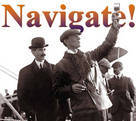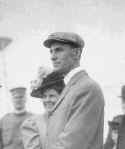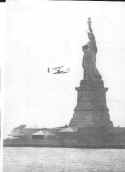|

 Up
Up 
 'Round the Lady
'Round the Lady 
(You are here.)



  Need
to Need
to
find your
bearings?
Try
these
navigation aids:
If
this is your first
visit, please stop by:
Something
to share?
Please:



|
|
Available in Française, Español, Português, Deutsch, Россию,
中文,
日本, and others.
 s
Wilbur filed his suit against Curtiss in New York, he was approached by the
Hudson-Fulton Celebration Committee. New York was gearing up to celebrate
300 years of history, including Hudson's exploration of the Hudson River
and Fulton's invention of the steamboat. They wanted to showcase the
Wright Brothers as the main event of this blow-out by having them make a
flight at least 10 miles in length or 1 hour in duration. Unbeknownst to
Wilbur, they also asked Glenn Curtiss to make a flight from Governors
Island to Grant's Tomb and back -- twenty miles round trip. s
Wilbur filed his suit against Curtiss in New York, he was approached by the
Hudson-Fulton Celebration Committee. New York was gearing up to celebrate
300 years of history, including Hudson's exploration of the Hudson River
and Fulton's invention of the steamboat. They wanted to showcase the
Wright Brothers as the main event of this blow-out by having them make a
flight at least 10 miles in length or 1 hour in duration. Unbeknownst to
Wilbur, they also asked Glenn Curtiss to make a flight from Governors
Island to Grant's Tomb and back -- twenty miles round trip.
Orville was overseas helping to set up a company
to make Wright machines in Germany, but Wilbur agreed to do it alone. He
went back to Dayton, collected Charlie Taylor and an airplane, and was
back in New York on September 20. The next day, Curtiss stepped off the
boat fresh from Rheims and found himself with a contract for an exhibition
flight but no airplane with which to make it. His new partner Herring,
without consulting Curtiss, had made another agreement with Wannamakers, a New York
department store, to display the Rheims Racer inside the store.
Curtiss made a brief run to Hammondsport and picked a new airplane.
Unfortunately, it had neither the power nor the speed of the Racer.
On September 30, with his New York contract just about
to expire, Curtiss made a short hop in the new aircraft and found it
didn't have the power necessary to fly safely in the winds that gusted in
from the harbor. Wilbur had just finished installing a canoe under his
airplane to act as a pontoon in the case of a forced water landing, and
his seized this opportunity to put Curtiss in his place. He made a brief
flight, circling the island to make sure the canoe would not adversely
effect the airplane's performance. Then he took off for the Statue of
Liberty. He made a sharp turn around Lady Liberty's waist as the boats in
the harbor sounded their horns in a boisterous salute.
Curtiss made another attempt to fly to Grant's Tomb a
few days later, and once again he put down because his aircraft could not
handle the winds. He decided to pack it in and withdrew his agreement from
the Celebration Committee. His took his airplane and left for St. Louis,
where he had another engagement for an exhibition flight.
The next morning, on October 4, Wilbur showed up to make
the long flight that he had promised and announced that he would combine
it with the flight that Curtiss had been unable to make -- he would fly up
the Hudson River to Grant's Tomb and back. With two American flags
fluttering from the front canard, Wilbur took off and flew up the Hudson,
passing over an enormous fleet of ships from all over the world. He flew
parallel to the western shore of Manhattan Island, where over a million
onlookers saw him fly, his red canoe dangling beneath a silver-painted
airplane. For 33 minutes, ships tooted, cars honked, trolleys
sounded their bells, and people cheered him on his way.
"It was an interesting trip," he wrote to his
father that evening, "and at times rather exciting."
|

Wilbur Wright at Governor's Island, across the river
from New York City.

The Wright Model A Flyer outside its hangar. Note that
one seat has been removed. Wilbur apparently didn't want to carry
passengers.

Soldiers roll out the Flyer from its hangar to the
launch rail.

An ocean liner passes by the island as the Flyer is
pulled to the launch rail.

Wilbur gets the Flyer ready. Note that for this launch,
Will did not use the catapult. If there were sufficient headwinds,
it wasn't necessary.

Will does a "walk-around," inspecting the
aircraft.

Over a million spectators watched from the banks of the
river.

Wilbur and Charlie Taylor installed a canoe under
the aircraft to serve as a float if the event of an emergency
landing in the water.

The Flyer is launched from Governor's Island.

Wilbur flies over the yacht "Viking."

Will approaching New York City.

Wilbur and the Flyer pass by the New York City
skyline.

Wilbur banks the Flyer over the Hudson River.

Wilbur approaches the Statue of Liberty.

Wilbur immediately after the flight. |